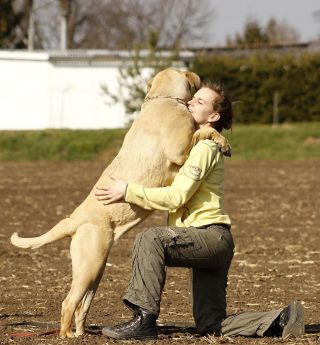Therapy
Help Your Teen Conquer Social Anxiety Disorder
Unleash self-confidence with canine-assisted psychotherapy.
Updated December 20, 2023 Reviewed by Gary Drevitch
Key points
- Social anxiety disorder is a prevalent, treatable mental health problem that often emerges in adolescence.
- Dogs act as a social lubricant to help teens engage with treatment for social anxiety.

Social anxiety disorder (SAD), also known as social phobia, is a mental-health condition characterized by intense and persistent distress in social situations such as conversing or eating with others, meeting new people, or having to speak or perform in public. People with SAD are fearful of being negatively evaluated, judged, or embarrassed in social situations.
Physical symptoms of the disorder include rapid heartbeat, blushing, sweating, trembling, nausea, and muscle tension. Emotional symptoms include social inhibition and intense self-consciousness; cognitive symptoms include distorted, overly critical self-perceptions and negative core beliefs.
The causes of SAD are multifaceted and complex, including hereditary, socio-ecological, and psychological factors. Susceptibility increases for those with a family history of mental illness, while others might develop symptoms following exposure to bullying, traumatic events, or stressful social encounters. Whatever the reason for its development, SAD can considerably affect one’s quality of life and general well-being.
In the United States, SAD’s median age of onset is early adolescence; 75 percent of those with the disorder experience symptoms by age 15. Unfortunately, social anxiety can be particularly troublesome in adolescence. It may significantly interfere with teens’ daily lives, increasing their isolation and loneliness while disrupting their ability to function at school, form relationships, and participate in social and recreational activities.
Without timely treatment, SAD can result in significant functional impairment. In severe cases, adolescents may withdraw from social interaction and refuse to attend school. Teens and young adults with SAD exhibit higher rates of high school dropout than those without the disorder. The negative consequences continue into adult life; people with SAD experience higher rates of unemployment and lower socioeconomic status and quality of life than those without social anxiety.
Cognitive-behavioral therapy (CBT) is the gold-standard counseling approach for addressing SAD; it is an effective and well-validated intervention for older children, teens, and adults. CBT is designed to help people recognize and alter unhelpful thoughts and change the behaviors that exacerbate their anxiety. However, it is an active and collaborative process; the client and therapist must work together to achieve successful treatment outcomes.
Socially anxious, avoidant teens typically struggle to verbalize their thoughts and experiences, and many have an internalized sense of shame about their emotional problems. These painful, complex feelings may be so overwhelming to some teens that they may feel unable to engage in psychotherapy. Others may agree to begin treatment but become so uncomfortable with the process that they end treatment before obtaining any symptomatic relief.
Canine-Assisted Psychotherapy
With their gentle, curious temperaments refined by thoughtful training, therapy dogs partner with specially trained psychotherapists in canine-assisted psychotherapy (CAP), an innovative modality that combines the healing power of animals with traditional therapeutic interventions.
Dogs can be outstanding helpers in psychotherapy due to their remarkable capacity to alleviate the stress, ambivalence, and mistrust that can lead clients to early treatment termination. This ability is particularly pertinent in the context of mental health treatment for adolescents, who may resist participation in conventional modalities due to the depth of their discomfort with unfamiliar adults and therapeutic activities.
CAP relies on the unique and powerful bond between dogs and humans to facilitate emotional growth. Dogs are integrated into the therapeutic process through structured and goal-oriented activities. Their non-judgmental, comforting presence can help socially anxious teens feel more at ease during therapy. Interventions that include the therapy dog aim to reduce stress and treatment ambivalence, enabling anxious teens to fully engage with the dog, the therapist, and the therapeutic process.
Therapy dogs are affiliative and outgoing; they enjoy and solicit social interaction and engagement. They demonstrate eagerness and interest rather than reluctance or shyness when meeting new people; this makes them a perfect foil for clients who struggle with social anxiety.
CAP is a complementary intervention that seamlessly integrates with established approaches like CBT, ensuring that clients receive holistic and effective care. Combining CAP with CBT improves treatment participation, enhances the working alliance between the client and the therapist, and reduces premature treatment termination. It creates an emotionally secure space for teens to learn the skills needed to reduce their anxiety and achieve lasting improvements in their mental health.
A recent study (Wong et al., 2017) evaluated the efficacy of canine-assisted interventions for severely anxious, socially isolated young adults. The subjects appreciated their interactions with the therapy dogs, noting that they did not feel judged or criticized by the dogs as they did with other humans. The researchers’ findings support the involvement of therapy dogs in interventions for socially isolated, treatment-ambivalent young people.
Finding a qualified provider for your socially anxious teen is crucial for effective and appropriate care. When searching for a practitioner, consider the following factors:
Credentials. Look for a mental health professional with specialized training in animal-assisted psychotherapy and experience with therapy animals. Your therapist should belong to a professional organization supporting animal-assisted activities, such as the Association for Animal-Assisted Intervention Providers (AAAIP). Membership in such an organization suggests that the therapist is committed to ongoing education in a learning community with other professionals. Dr. Taylor Chastain Griffin, AAAIP’s executive director, reports that “demonstrating professional competency and awareness of best practices when partnering with therapy animals is critical to the well-being of all involved in the intervention. AAAIP offers coursework, professional collaboration, and benchmarks like the Animal-Assisted Specialist Certification so that professionals have a clear path to the best possible practice of animal-assisted interventions.”
Experience. Seek a therapist who is well-experienced with adolescents, the treatment of anxiety disorders, and CAP. This professional experience will help ensure that they understand SAD’s unique challenges and can effectively integrate CAP into your teen’s treatment plan.
Therapy Dog. The dog in your sessions should be polite, friendly, and well-engaged. Discuss any concerns about the dog with the therapist to ensure the best possible experience. The therapist should show you the dog’s health and training certificates. Feel free to ask about the therapy dog’s qualifications. All therapy dogs should be currently registered with a recognized therapy-dog organization.
Conclusion
Canine-assisted psychotherapy offers an innovative approach to mental health care that can be particularly beneficial for socially anxious, avoidant teens. Contact your child’s healthcare provider to learn more about SAD and discuss your treatment options.
To find a therapist, visit the Psychology Today Therapy Directory.
References
American Psychiatric Association. (2022). Diagnostic and statistical manual of mental disorders, fifth edition, text revision (DSM-5-TR).
Leigh, E., & Clark, D. M. (2018). Understanding social anxiety disorder in adolescents and improving treatment outcomes: Applying the cognitive model of Clark and Wells. Clinical Child and Family Psychology Review, 21(3), 388–414. https://doi.org/10.1007/s10567-018-0258-5
Wong, P. W., Yu, R. W., Li, T. M., Lai, S. L., Ng, H. Y., & Fan, W. T. (2019). Efficacy of a multicomponent intervention with animal-assisted therapy for socially withdrawn youth in Hong Kong. Society & Animals, 27(5-6), 614–627. https://doi.org/10.1163/15685306-12341462




